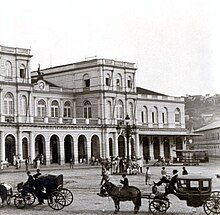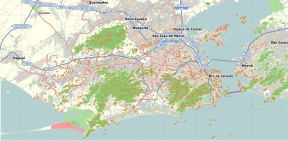Central do Brasil
You can help expand this article with text translated from the corresponding article in Portuguese. (July 2011) Click [show] for important translation instructions.
|
 View of the station | |||||||||||||||||||||||||||
| General information | |||||||||||||||||||||||||||
| Location |
Brazil | ||||||||||||||||||||||||||
| Coordinates | 22°54′12.29″S 43°11′29.20″W / 22.9034139°S 43.1914444°W | ||||||||||||||||||||||||||
| Owned by | |||||||||||||||||||||||||||
| Operated by | |||||||||||||||||||||||||||
| Platforms | Island and side platforms | ||||||||||||||||||||||||||
| Connections | |||||||||||||||||||||||||||
| Construction | |||||||||||||||||||||||||||
| Structure type | At-grade | ||||||||||||||||||||||||||
| Architectural style | Art deco | ||||||||||||||||||||||||||
| Other information | |||||||||||||||||||||||||||
| Station code | CBL/DPO | ||||||||||||||||||||||||||
| History | |||||||||||||||||||||||||||
| Opened | 29 March 1858 | ||||||||||||||||||||||||||
| Rebuilt | 1943 | ||||||||||||||||||||||||||
| Electrified | 1937 | ||||||||||||||||||||||||||
| Previous names |
| ||||||||||||||||||||||||||
| Services | |||||||||||||||||||||||||||
| |||||||||||||||||||||||||||
| |||||||||||||||||||||||||||
| |||||||||||||||||||||||||||
Central do Brasil (Portuguese pronunciation: [sẽˈtɾaw du bɾaˈziw]) is a major train station in the Brazilian city of Rio de Janeiro. It is the last stop of Rio's railway network, as well as a hub for connection with the city subway[1] and a bus station. Central do Brasil was also a preeminent stop in the interstate Central do Brasil railroad, which linked Rio de Janeiro with São Paulo and Minas Gerais, though the railroad is now deactivated. The station is located in downtown Rio de Janeiro, along the Avenida Presidente Vargas and across from the Campo de Santana park. It was built in the Art Deco style.
History
[edit]
The construction of the first station in the centre of Rio de Janeiro began in 1855 on behalf of the Companhia de Estrada de Ferro Dom Pedro II (the Dom Pedro II Railroad Company), to serve as the terminus of the new Estrada de Ferro Dom Pedro II (Dom Pedro II Railway) which was to connect the city, then the capital of Brazil, with the provinces of São Paulo and Minas Gerais. The location chosen for this station was the Campo de Santana, an area close to the city center and at the time the site of many government buildings. Its construction necessitated the demolition of the Igreja de Santa Ana (Church of Saint Anne) dating from 1735. The station, then known as the Estação da Corte or Estação do Campo, was opened along with the first section of the railway line in the presence of Emperor Pedro II, Empress Teresa Christine and the bishop.[2][3]

Already in 1870, the station was renovated and enlarged following a project by Jorge Grademaker Grunewald, in order to accommodate the growing number of passengers living in the new suburban districts served by the train. The project preserved the appearance of the old station building with a central building flanked by two large side wings and had a station clock in the centre. From 1876 to 1880, new warehouses were built under the direction of Francisco Pereira Passos.[2] On 21 November 1879, electric lighting was installed in the station as a first for a public building in Brazil.[2] In 1906, one of the wings was destroyed by fire.
On 2 December 1925, by decree of the then President of Brazil Artur da Silva Bernardes, the station was renamed Estaçao Dom Pedro II (Dom Pedro II Station) in honour of Emperor Pedro II at the occasion of the centenary of his birth in 1825.[2][3]

A new station building in art deco style (which also served as the seat of the Estrada de Ferro Central do Brasil) opened in 1943,[4] and was completed in 1945.[3]
Layout
[edit]Track layout | ||||||||||||||||||||||||||||||||||||||||||||||||||||||||||||||||||||||||||||||||||||
|---|---|---|---|---|---|---|---|---|---|---|---|---|---|---|---|---|---|---|---|---|---|---|---|---|---|---|---|---|---|---|---|---|---|---|---|---|---|---|---|---|---|---|---|---|---|---|---|---|---|---|---|---|---|---|---|---|---|---|---|---|---|---|---|---|---|---|---|---|---|---|---|---|---|---|---|---|---|---|---|---|---|---|---|---|
| ||||||||||||||||||||||||||||||||||||||||||||||||||||||||||||||||||||||||||||||||||||
In popular culture
[edit]In cinema
[edit]The film Central Station, by Walter Salles, is set in the station of the same name. [5]
Gallery
[edit]-
Former building of the Estação Dom Pedro II, 1889
-
Former building of the Estação Dom Pedro II, 1906
-
Former building of the Estação Dom Pedro II, 1910s
-
Building of Central do Brasil, 1957
-
Trains at Central do Brasil, 1979
References
[edit]- ^ "Central - Sobre a Estação". MetrôRio. Retrieved 16 September 2014.
- ^ a b c d Memória do Trem, ed. (2004). A formação das estradas de ferro no Rio de Janeiro : O resgate da sua memória (in Portuguese). pp. 28–31. ISBN 85-86094-07-2.
- ^ a b c Cornejo, Carlos (2005). As ferrovias do Brasil nos cartões-postais e álbuns de lembranças (in Portuguese). Solaris Editorial. p. 21. ISBN 978-85-89820-02-8.
- ^ Bosco Setti, João (2008). Brazilian railroads (in Portuguese and English). Memória do Trem. p. 41. ISBN 978-85-86094-09-5.
- ^ McCarthy, Todd (8 February 1998). "Central Station". Variety. Retrieved 31 January 2024.
External links
[edit]![]() Media related to Estação Central do Brasil at Wikimedia Commons
Media related to Estação Central do Brasil at Wikimedia Commons
- Line 1 (Rio de Janeiro)
- Metrô Rio stations
- SuperVia stations
- Art Deco architecture in Brazil
- Transport infrastructure completed in 1937
- National heritage sites of Rio de Janeiro (state)
- Railway stations in Brazil opened in 1858
- South American railway station stubs
- Brazilian building and structure stubs
- Brazil transport stubs






